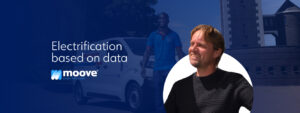Electrification, driver safety, efficiency and optimisation are currently the main challenges faced by fleet managers at large companies operating internationally. Moove’s innovative technology helps them make their fleets futureproof. That means data is crucial for effective decision-making. Joost van Rietbergen, Business Development Manager at Moove, illustrates several use cases to explain data’s critical role in optimising fleet performance.
Focus on last-mile-delivery logistics and service fleets
Moove focuses primarily on two vertical markets: last-mile delivery and service/installation fleets. These fleets’ characteristics are ideally suited for data optimisation. One clear difference with other logistics operators is that postal company drivers are assigned zones solely by postal codes, leaving them free to plan their routes. Drivers for last-mile delivery fleets such as HelloFresh, Jumbo, AH, and other supermarket chains have far longer routes with specific addresses and delivery times. “There’s a big difference in mileage between these two types of fleets,” Joost says. “About 50 km a day on average for a PostNL van, while a HelloFresh van may drive anywhere from 200 to 400 km daily. Within this vertical market, you have a variety of use cases where data can help.”
The drivers do not own their service fleet vehicles, but each vehicle is assigned to a specific driver. “Data about private use is a relevant factor here,” Joost explains. “Moreover, electrification is a challenge in this market because drivers often indicate that transitioning to electric vehicles is not feasible because their mileage is too high. These are clearly cases where data can make a big contribution to decision-making.”
Use cases set the tone for best practices
These verticals are based on three themes: social well-being, sustainability and economic growth. “Social well-being primarily concerns the driver directly and the fleet’s impact on society,” Joost explains. “We believe that, as an employer, you must help the driver navigate traffic safely. Moreover, the vehicles have a societal impact, especially when people associate company vehicles with vans driving down streets at breakneck speeds. This association negatively impacts both the company’s image and society at large.”
“Driver safety is mostly about driving behaviour. Within this area, the data focuses on acceleration, braking and turn-based behaviour, seatbelt usage and speed. Excessively high speeds are usually responsible for personal injuries, excessive fuel consumption and significant damage. Therefore, reducing top and average speeds in different speed zones is a top priority for many businesses. With the collected data, companies can hold drivers directly accountable for their driving behaviour. Still, some businesses are not allowed to monitor individual driver scores on driving behaviour. In that case, they can work with drivers at a location level. One of our customers decided to focus on driving behaviour in their fleet in Spain. Their score improved by 10 points in no time. In concrete terms, this meant that speeding instances dropped by half, from 36,500 to 17,000 instances each week!”
Data as a basis for electrification
Sustainability primarily concerns electrification, fuel consumption and wear and tear on tyres. Many businesses’ ambition is to make their fleet more sustainable. Data is critical for companies that want to achieve that. “We see quite a bit of resistance among drivers when it comes to electrification,” says Joost. “Drivers think their mileage is too high for electric driving, but their perception is not based on any type of data. The basis for choosing to go electric depends on the daily mileage per vehicle. This data alone will provide an accurate overview of how you can electrify your fleet. Let’s say that vehicles drive about 120 km each day, with the occasional outlier at 230 km. Such figures show that electrification is a perfectly viable option. As a result, you no longer have endless discussions about whether it’s feasible. Instead, you can move on and focus on the next step: figuring out which electric vehicles suit your needs. This use of data proved to be a great asset for our customer Hoppenbrouwers Techniek in moving forward with the electrification process.
Economic growth
Economic growth concerns maintenance, TCO, utilisation, uptime, and whether your fleet has too many or too few vehicles. “We see with all our last-mile-delivery customers that they usually have part of their fleet standing idle at a depot. Data will help you gain insight into all your depots, allow you to link each vehicle to a specific depot, give you an overview of damage locations, and provide you with precise details on which vehicles are on the road each day. With one of our customers, this data showed us that, on average, 20% of their vehicles were not being used on any given day. Suppose you have 60 vehicles in a depot, of which 12 are never scheduled for delivery routes. Those 12 vehicles still cost 1,000 euros per vehicle each month. When you extrapolate that to all the depots throughout Europe, it could amount to millions of euros. This is a very simple use case that generally leads to the biggest savings for last-mile-delivery customers.”
“Another interesting insight is that you often find significant differences between depots. One depot could be running at full capacity or more, renting vans to pick up the surplus routes, while another depot could be operating at just 70%. In light of the data, you can exchange vehicles between depots to operate at 100% capacity without having to rent additional vans. And ultimately, you can use the data to remove any vehicles you don’t need. Just imagine the savings if you could run a fleet with 150 fewer vehicles.”
Would you like to learn more about these use cases and how our latest technology can support your business? Request a demo now.












